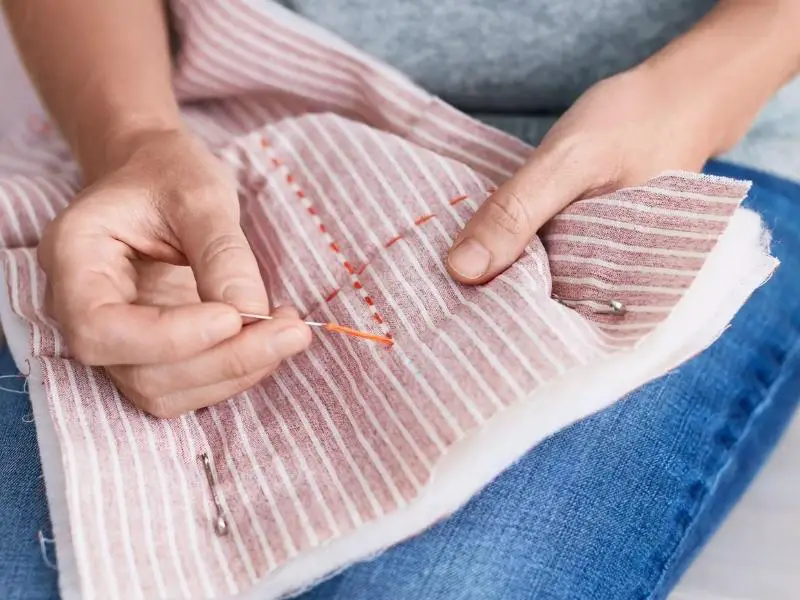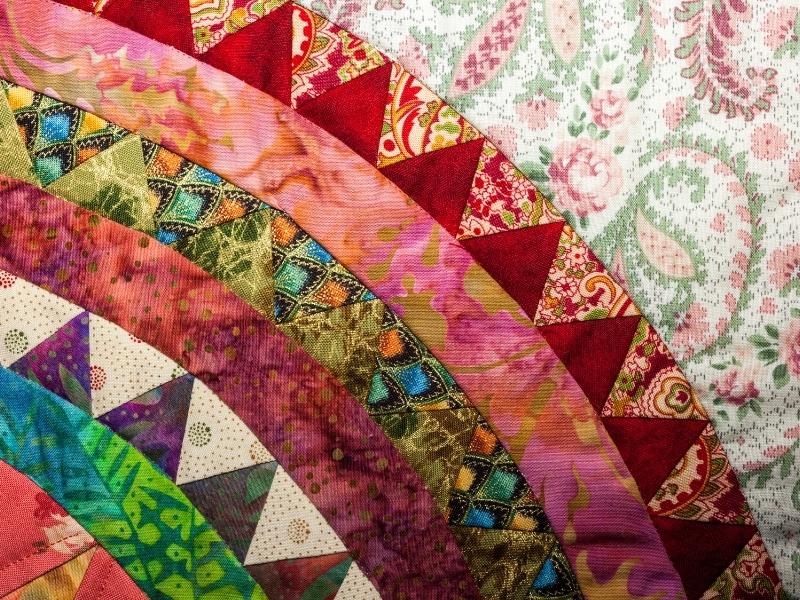If you love quilting, you’ll know all about quilting with a hoop and how it takes stress off your hands. However, there’s an ongoing debate about the usefulness of hoops and how quilting with one isn’t always the way to ease off stress.
Sometimes, depending on the size of what you’re quilting, you might need to ditch the hoop and do better quilting with your hands.
Hand quilting requires skills and special techniques, and in this guide, we’ll focus on how to hand quilt without a hoop. So, let’s cut to the chase!
The 3 Basic Steps to Hand Quilting Without a Hoop
Below are the steps required to hand quilt without a hoop:
Step 1: Cutting the Thread
First, select the thread appropriate for what you want to quilt and cut it to 19 ““ 25 inches. This length allows you to hand quilt without struggling with tangles or constant re-threading.
Next, thread your needle with the specified thread length, and tie a knot as always. Finally, choose a spot where you want your stitches to begin, stick your threaded needle in the quilt, and pull it through the back of your desired spot.
You want to make sure your thread is knotted correctly at the end. So, give it a couple of tugs to ensure the knot doesn’t unravel or slip through the small holes.
Step 2: Stitching
You should stick to small and even stitches to end up with neatly sewn quilts. But, if you’re a beginner quilter, you should fare better with bigger stitches and a simple stitch pattern.
Start with six stitches per inch, and use your pencil, tailor’s chalk, or other marking tools to draw your thread path.
You can get clean-looking, professional quilts by making 8 ““ 12 stitches per inch and pushing the loose fabric onto the needle.
Step 3: Loading the Stitches
You don’t have to pull the thread up every time. Instead, load your needle before pulling it through the quilt. You can load up to 3 stitches at a time on your needle before pulling it through all the layers.
When you load your stitches properly as you quilt by hand, you’ll end up with beautiful and uniform stitches.
Supplies For Hand Quilting Without a Hoop

Some of the materials you’ll need to hand quilt without a hoop include:
Thimble
Quilting by hand is a long process in terms of time and work. Also, pushing the needle with your fingers can hurt them. Using the thimble helps you work faster, and your fingers won’t feel the work so hard.
You can pick a metal or leather thimble, depending on which one you prefer. If you aren’t a fan of the more traditional metal, plastic, or leather thimbles, there are also special pads you can stick to your fingers.
If you have large fingers, some companies offer customized thimbles tailored to your perfect fit. Make sure you test your thimbles for comfort and maximum protection before beginning.
Scissors
You’ll constantly cut the thread, either to start the quilting or to cut the thread when you finish the needle thread. We recommend you have a pair of pointed scissors with good sharpness that’s easy to work with.
Also, it should be small and light, suitable for cutting through the awkward corners and angles, but sharp enough to cut your threads and materials.
Ruler
Quilting requires almost 100% accuracy, and this is where rulers come in. Any hand quilting ruler could do the work, but we recommend an acrylic ruler for its transparency. In addition, you can see your fabric through acrylic rulers to make better and more accurate cuts.
Needles
Select an ideal needle for the material you’ll be working with. You can hardly ever go wrong with thick, long, hand-quilting needles.
You can find the famous quilting needles in stores that sell everything to make quilts or patchwork. The needles have tiny eyes, and they’ll help you make small quilting stitches.
Thread
Depending on where you live, you can find the thread made especially for quilting. Of course, it’s more expensive, but it’ll help you make your quilts very well.
It’s best to stick to 100% cotton threads when working on traditional quilting. These threads pass through the material easily, and the thread coating helps avoid tangles.
Marking Tools
Use markers that are quilt-friendly and easily washable. For example, you can use a pencil, tailor’s chalk, or washable markers.
Using the right supplies as you begin your quilting practice will ease your tension as a beginner.
What Stitching Technique Can You Use to Quilt by Hand?

You can build your confidence by practicing your hand quilting on an old piece of clothing using the following stitching techniques.
Quilter’s Knot
The quilter’s knot is perfect for beginning and ending the pattern of your stitch. The technique is easy to master. First, wrap around the needle three times, and pull the three loops down the yarn to form a knot. Next, cut out the remaining thread, and start stitching from the center of your quilt.
Running Stitch Pattern
Quilters sewing without a quilting hoop frequently use the running stitch pattern. This is because it’s pretty easy; you’ll start by inserting the needle through the front of the fabric and pulling it (with the thread on it) to the back of the material.
In the same way, keep stitching several times until you have a smooth line of running stitches. You can stitch fast with the running stitch technique by loading several stitches on the needle before you pull the thread back up.
Rocking Stitch
You stitch from the top with one hand under the fabric’s bottom layer in this technique. The name “Rocking stitch” comes from the rocking motion you make as you use your hand to work on the material.
Repeat this pattern and the rocking motion between 4 ““ 5 times, then pull out the thread. Using this rocking stitch method, you should use a thick needle without looping the thread. The final product is usually a smooth line of stitches.
Tunneling Stitch
You can create even stitches with the tunnel stitch technique, which requires holding the needle parallel to the fabric. You might be used to machine quilting, but hand quilting stitches, when done right, will get you a beautiful and neat quilting design.
If you prefer quilting without a hoop, practice these basic stitches, and you’ll soon be a professional.
Making Large Quilts Without a Hoop

If you’re hand quilting a large quilt without a hoop, you’ll probably do that by basting.
First, place your layers on any flat surface, such as your work table or floor. Ensure you place the layers in the proper order. Then, use a washable marker or a pencil to create the beautiful quilt designs you want before you begin stitching.
After that, start basting from the center of your quilt to the corners as smoothly as possible. If you don’t like this technique, you can pin the fabrics together and create a fabric sandwich.
Aim your first stitch an inch away from where you want it to appear at the top of the material. Next, insert your threaded needle through the batting and pull it out again to the backing. Keep pulling the threaded needle until the knot hits the fabric layers.
If you’ve previously drawn lines with tailor’s chalk or washable marker for your designs, sew along these lines and make sure your needle passes through the layers.
After you finish a line of stitches, make sure you pull the knot through the fabric to hit the middle of the layers. You shouldn’t be able to see the knots you’ve constructed on the top of the quilt. Once you finish stitching the designs, remove the basting.
Traveling With the Needle When Hand Quilting
If you finish a line and there’s still excess thread left in your needle, you can move to another section and start stitching again without knotting your thread.
This method is used for smooth lines on some quilting designs and is known as “traveling.” However, if you’re traveling more than 2 inches, you’d be better off knotting the thread and starting again.
How Long Does Hand Quilting Take?
The length of time it takes to hand quilt depends on some factors. Let’s consider some of them below.
Size
The size of your quilt largely determines how long it’ll take you to complete hand quilting. Expert quilters could finish a small quilt suitable for a baby in a few hours, or less than a day, while larger quilts could take anything from weeks to months to finish.
Since we’re here, if you’re planning on quilting your first design for your baby, check craftwhack.com to choose the best batting for a baby quilt.
Design
The design you have chosen for your quilt also comes into play when estimating how long the final product would take. Some patterns are incredibly intricate and require great attention to detail, especially as you’re stitching by hand.
If you’re hurrying to finish your hand-stitched quilt, you should select larger designs and more simple patterns that require big stitches.
Experience
Your experience level goes a long way in determining if you’ll quickly finish hand stitching your quilt. Due to years of practice, experienced quilters can give an almost accurate estimation of how long it would take them to complete desired designs.
For beginners, start with easier patterns and designs like hearts and flowers before graduating to the more complex ones. You can also spend your free time practicing several stitches on old T-shirts.
Final Thoughts
Quilting is one of those easy and enjoyable art and crafts activities that you can take up as a relaxing pastime. You can also explore your talents through this activity.
Some people would recommend using a quilting hoop to stay as accurate as possible, but you could ditch hoop quilting if you prefer going lightweight.
Furthermore, there are three significant steps to start hand quilting without a hoop. They include cutting your thread, stitching, and loading the stitches. Also, some of the materials you’ll require to make a handmade quilt include a thimble, scissors, ruler, needles, thread, and more!
Comments
0 comments


